December 4

Cheering on and Welcoming the PyeongChang Cultural Olympics
In preparation for the PyeongChang Olympics, the Korean Arts and Culture Education Service (KACES) collaborated with the Ministry of Culture, Sports and Tourism (MCST) and Gangwon Province to develop and promote the <One School, One Country Cultural Exchange Project>. Despite the fact that PyeongChang is home to the 2018 Winter Olympics, the actual region and its residents do not have many opportunities to access to arts and culture education. To address this, KACES developed the <One School, One Country Project> to introduce arts and culture education to Gangwon-do’s elementary, middle, and high school students, with the goal of help raising awareness and interest in the Winter Olympics, and continuing efforts beyond that for ongoing culture exchange. The PyeongChang Cultural Olympics’ <One School, One Country Cultural Exchange Project> began in a similar manner to other events held for each Olympics in the past, where schools of the host country work together with the participating countries under the common motto of “schools cheer on the countries.” Following the start of the program’s development, plans were changed from previous years under the direction of KACES, MCST, and the host province of Gangwon to create both a more festival-like event and where participants could experience various cultures. Further steps were taken through collaboration with artists of different specialties to create a rich program based on arts and culture education. For the six months leading up to the Olympics, 40 elementary, middle, and high schools were matched 1:1 with the participating countries and the students were given various opportunities for cultural exchange. The final product of these exchanges was the parade held by the students on February 12th to show their support for the participating country's’ athletes and other participants.True Friendship through Arts and Culture Education <One School, One Country Cultural Exchange Project>: The Hands-On Program
30 elementary, middle, and high schools participated in the hands-on aspect of the <One School, One Country Cultural Exchange Project>. This part of the program consisted of a close collaboration from start to finish between the participating country's’ respective embassies and the schools. Based on the recommendations of each country’s embassy, ambassadors, professors, artists, and other experts were invited to help conduct lectures and culture and arts workshops. Through this hands-on program, participating students were able to learn about and thus build a greater understanding of the participating countries through arts and culture education. For many of the students, it was their first time interacting with those who looked different and used a different language from them. For educators, this program provided the very international exchange that they had desired to provide for their students, but were unable to due to various limitations. More than anything, this project was an exemplary case of arts and culture education bringing people from different parts of the world closer together. The way the classes were conducted was also rather special. These were not your standard lectures, but highly interactive learning experiences: a children’s author read Anne of Green Gables and taught students about Canadian culture, representatives from the Latvian embassy worked with the students to prepare a Christmas tree and experience a Latvian Christmas, and the Czech consul, also a former hockey player, led a workshop on the different sporting events of the Winter Olympics. These are just a few examples of the various, interactive learning experiences that the students were exposed to in collaboration with representatives from the 30 participating countries.



Expressing Children’s Artistic Imagination through Art <One School, One Country Cultural Exchange Project>: Festival Program
10 schools located in a remote part of Gangwon Province were selected to prepare and participate in a parade to cheer on the athletes and other participants of the PyeongChang Olympics. Students from these 10 schools had little exposure to global culture and cultural aspects outside of their own; as part of this program, they had the opportunity to meet and make friends with students from 10 countries across six continents. These children had their first “global” experience through traditional music and then proceeded to learn about folklore, culture, traditions, and even contemporary aspects of their respective partner countries, ultimately serving as a large-scale cultural exchange for these students. Following this initial exchange, each school prepared its own parade props to reflect the respective country it was matched with, and joined together with artists from various fields to plan the entire parade. The school matched with Switzerland went chocolate shopping, while the school matched with the United States of America brainstormed what it would be like to be on the other side of the world and made their own creations to represent what they felt. The students received help from artists in the form of music, instruments, costumes, and other props to complete their creations. A student with trypophobia represented the holes of a lobster as lobster claws rather than circles, an aspiring police officer created robotic armor to become a robot that would protect others, and a student with an interest in multiculturalism imagined what it would be like to become friends with someone on the other side of the world. These and many other creative projects were planned and completed by the students and then presented in a grand parade to cheer on all of the Olympic athletes and other participants.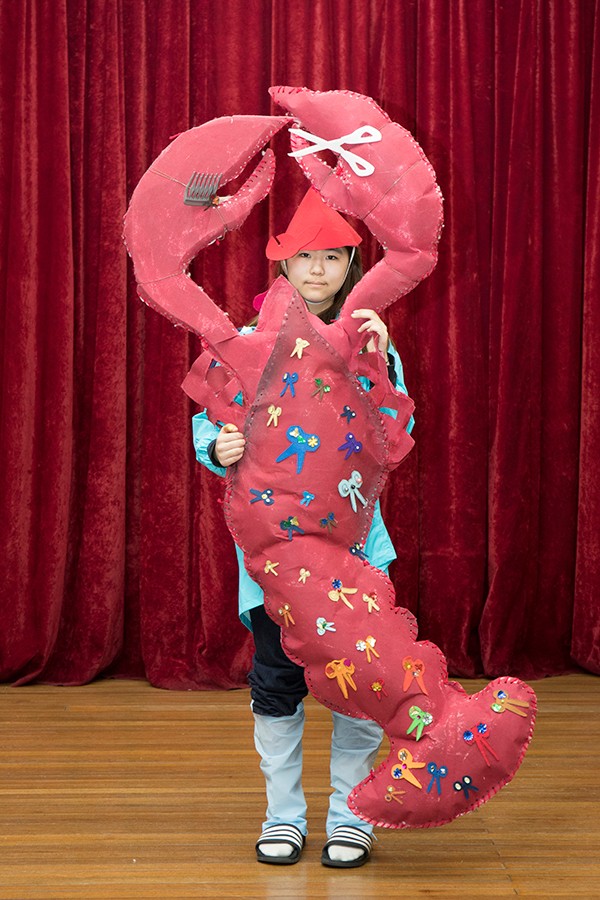
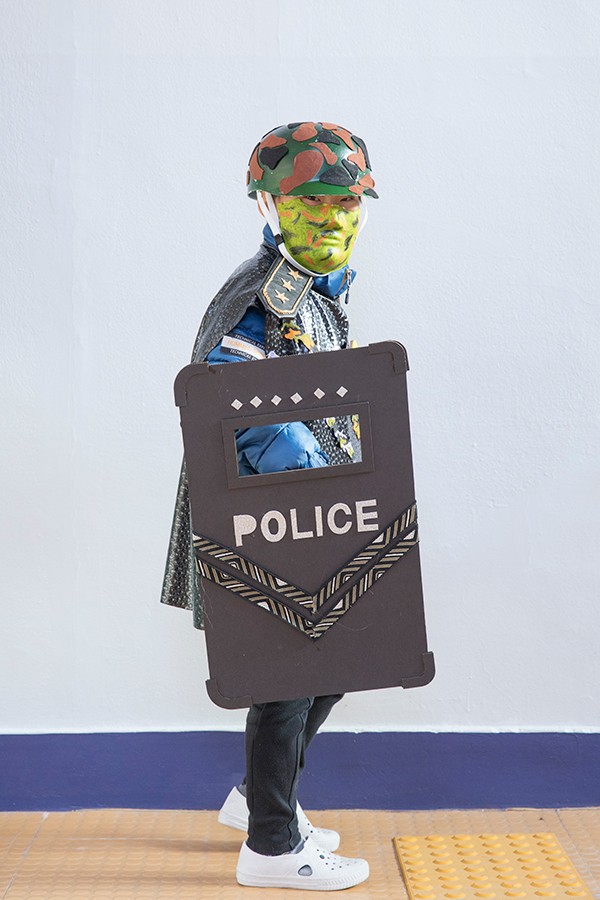
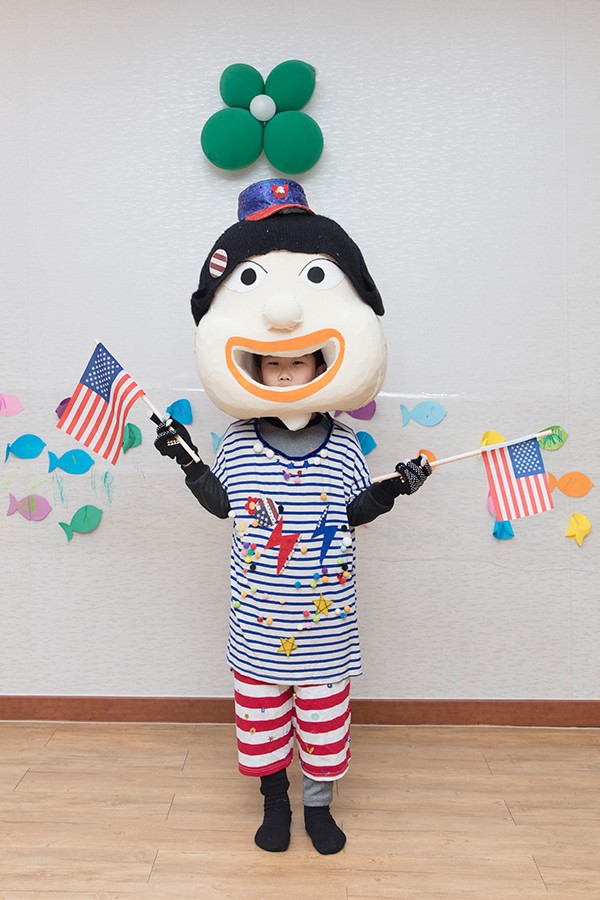

Heartfelt Messages and Support through Arts and Culture Education
The <One School, One Country Cultural Exchange Project> was introduced with the participation of 40 schools in Gangwon Province, with the goal of not only welcoming the Olympic athletes and visitors from other countries, but also to promote international exchange through cultural education.
Students collaborated with various relevant institutions throughout the entire course of the program, from its planning and management to participating in the final production in the form of a parade.
The institutional bodies that helped make this program possible included the embassies of the participating countries, the PyeongChang Winter Olympic and Paralympic Committee, and the local government and education office of Gangwon Province.
Furthermore, these collaborative efforts helped solve issues faced in realizing the goal of the overarching project for a “global Olympic event” to ensure that all countries, even those that are not participating in the Olympics or those with weak Olympic preparation infrastructure, are included and given the opportunity to enjoy the Olympics like every other country.
Over the course of the program, there were instances of unfortunate news, such as that Russia and some of the countries that were matched with the schools originally for cultural exchange were unable to participate in the planned events.
However, despite a few minor setbacks, the proposed plans were conducted as scheduled at each school and the participating students were able to complete their experience of showing their support for the athletes and participants and learning about various cultures from around the world.
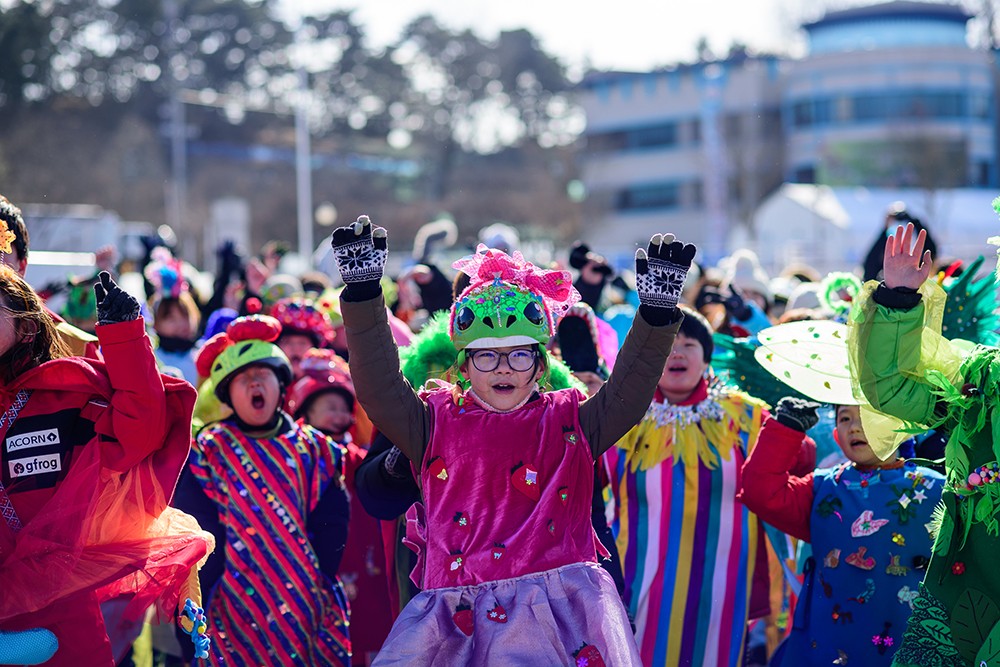
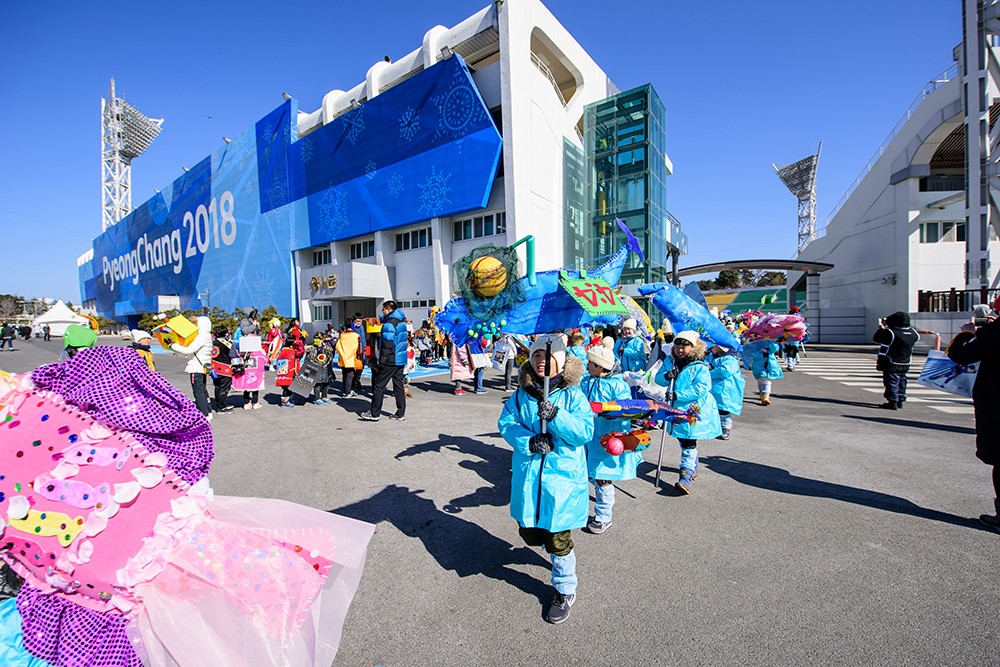
On February 12th, the children’s hard work and planning was displayed in their completed parade, cheering on the Olympic and Paralympic athletes, tourists from participating countries, and all others who were part of the Olympics.
Through this experience, the participating students helped create a truly “global celebration” of the Winter Olympics, and shared their smiles and messages of encouragement with everyone who watched.
Although the <One School, One Country Cultural Exchange Project> came to an end with the end of the 2018 PyeongChang Winter Olympic and Paralympic Games, the friendships, lessons, and emotions experienced and expressed by the participating students will linger and remain in our memories for a long time.
*Posted by Jeon Ah-Reum, International Affairs Team, KACES
The Arts Dream Camp, A Place for Everyone
“Trying something new is always fun and enjoyable. After learning how to play instruments from Korean teachers, I can’t wait to perform together with my friends from other countries.”
– Arts Dream Camp participant from Malawi
Further building interest in the 2018 PyeongChang Winter Olympics was the Culture Olympiad, a cultural event with the goal of bringing together people from all over the world. The purpose of this event was to help countries that do not have a winter season and thus are unable to experience winter sports, to feel included in the Winter Olympics celebration. As part of the PyeongChang Arts Dream Camp, children from these hot countries met in Korea under the common theme of art to imagine a cold winter and winter sports. From 2016-2017, Korean artists and children from Indonesia, Malawi, Vietnam, and Colombia met for educational workshops in their home countries. Following this one-year educational program, some of the students were then invited to Korea in January 2018 to partake in arts and culture education camp for seven days and six nights. The final production following the exchange in the students’ home countries and in Korea was displayed on January 12th at Mary Hall in Sogang University through a performance under the theme of <Dream of PyeongChang>.
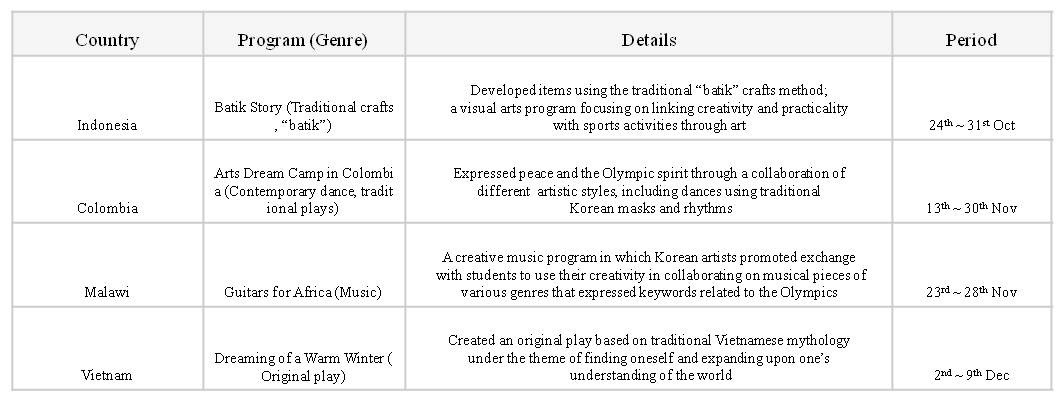
On-site Educational Programs in the Four Participating Countries
From October to December 2017, Korean artists visited four countries to meet the participating students. Following the Arts Dream Camp held in 2016, the artists were determined to develop a more systematic educational program that provided the participants with a deeper learning experience. Whereas the first camp in 2016 was focused on teaching about imagining snow, the Winter Olympics, and the cold, the 2017 camp took the educational themes a step further and focused on the expression and understanding of harmony, dreams, peace, and how these tie in with sports.
The arts education program held at the Alam Batik Center in Indonesia dealt with tying together the traditional arts and crafts style of “batik” with sports activities. Participants not only learned about batik, but also went around nearby villages to find materials used in batik art and created scarves in the traditional style. They also had the opportunity to try curling and other Olympic sports first-hand, learning more about batik while expressing their creativity and having fun in the process.
For the “Arts Dream Camp in Colombia” program, renowned theater actor Yoo Hong-young and other artists from Korea’s traditional music and mask dance groups participated and exchanged with students from El Colegio del Cuerpo. Through this program, they taught participants traditional Korean dances and dance music, and how these forms of art can be used to express finding hope during times of hardship, violence, and poverty. Using traditional dance and music as a form of communication, the artists worked with the students to create a performance that symbolized the key theme of dreams.
At the Lusubilo Center in Malawi, where the heat was almost unbearable, reaching temperatures over 40 degrees Celsius, Korean musicians including Harim held the “Guitars for Africa” program, which focused on using the passion and rhythm of traditional African music to create an original song. The song was developed under the theme of the Olympic spirit, and the course of the program was covered in the KBS documentary “Exciting Beats from Malawi.”
Lastly, the Ho Chi Minh City National University of Social Sciences and Humanities was the site of the program held in Vietnam. This program was a theatrical arts program under the theme of “Dreaming of a Warm Winter.” It was the first time that the participating Vietnamese students had ever taken part in a play, which as part of this program would take aspects of traditional Vietnamese mythology in creating the performance. This was an especially exciting opportunity for students in the Korean Language Department, as they were able to exchange ideas in person with Korean artists and not only help teach about their own country and culture, but also learn more about themselves as individuals and as proud Vietnamese citizens, all while expressing themselves freely.
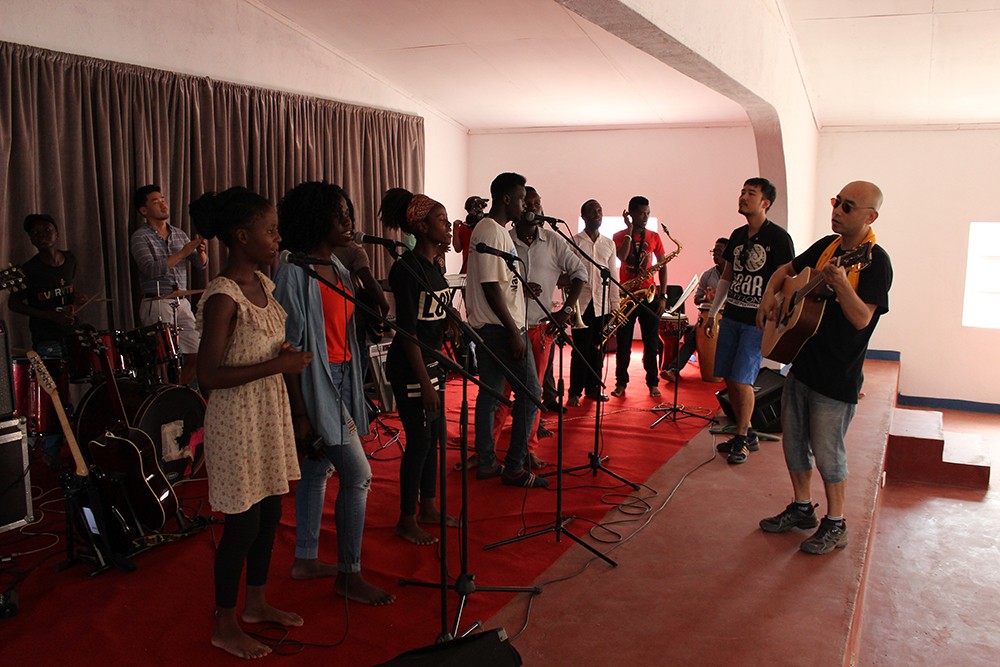
[Related Link]
*KBS Documentary("Exciting Beast(흥興), Heung) from Malawi")
The celebration of the Festival, the Arts Dream Camp
“It’s really cold outside, but I can feel the warmth of everyone and the atmosphere. It’s so exciting and interesting to be able to prepare for this performance, and I’m so happy to be a part of it!”
– Arts Dream Camp Participant
Some of the participants from each of the participating countries were invited to Korea for seven days and six nights for the Arts Dream Camp, with some of them having to travel for more than 20 hours. They were met with one of the coldest winters in Korea, arriving on January 6th, when they were met with the Korean participants in the camp with warm smiles and messages of welcome. Although many of the participants from abroad were exhausted from the long trip and the sudden, inclement weather, that soon subsided as the camp began and they had skating lessons, a welcome party, and other forms of exchange that made the trip worthwhile.
The participants finally had the opportunity to visit PyeongChang, where they were able to experience a winter atmosphere that they previously could have only imagined, as well as the site of the Winter Olympics. There, they tried sledding, made traditional Korean lanterns at Gangneung Artist Village, and took a field trip to the Olympics Pavilion to learn more about the PyeongChang Olympics. For the students who saw snow for the first time, it was as if their imaginations had become reality.
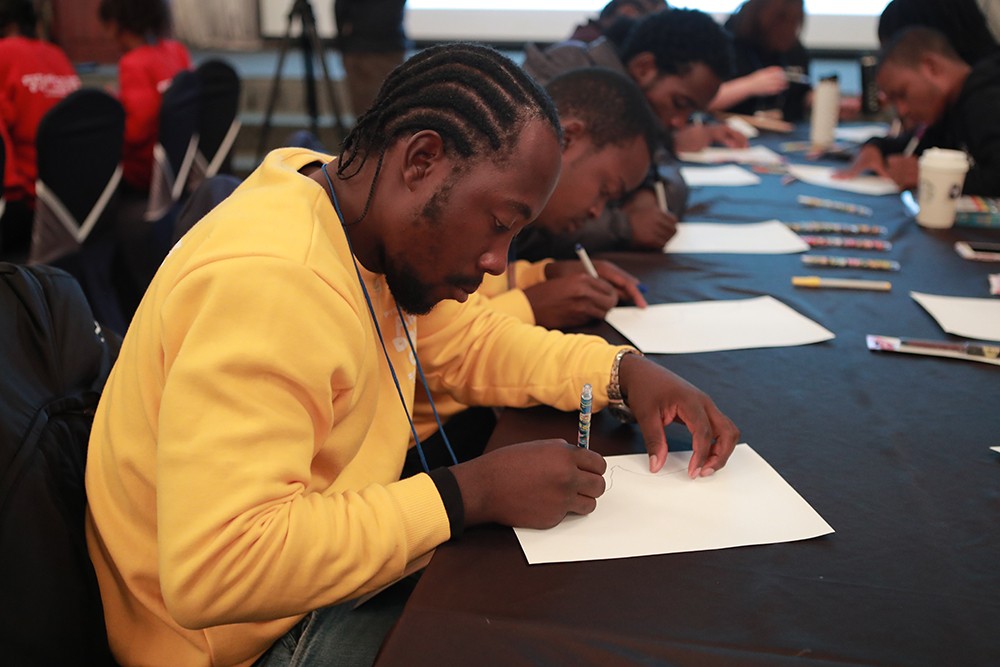
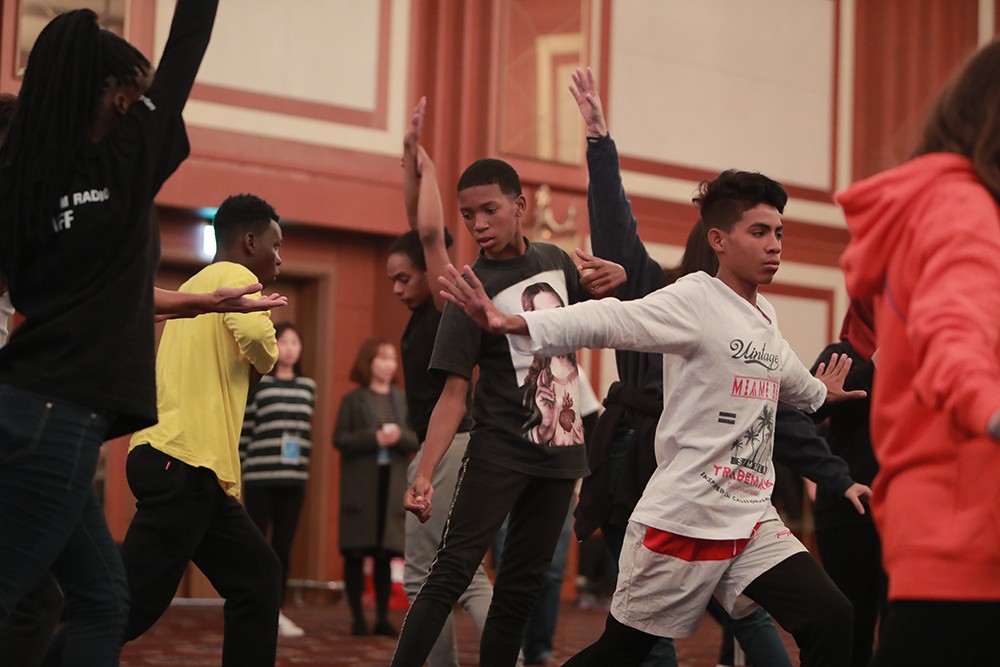
Throughout the duration of the camp, the students from the five countries participated in arts education workshops, which were divided into the following: individual workshops for each country to prepare for the final performance, a collective workshop for all participants to learn the dance for the final group performance, and a photography workshop for the students to reflect upon themselves and their dreams for their future selves. It was through these workshops that the students’ hard work over the past year came to fruition.
Under the common concepts of peace, purity, compassion, energy, and dreams, the students from different countries came together as one to give their final performance, “Dream of PyeongChang.” They also created an exhibition entitled, “Snow, the gift of dreams” that captured their one-year experience participating in the Arts Dream Camp. Throughout their time, the students were dedicated to and diligent in meeting their goals, and were not merely on the sidelines, but actively participated in sharing their ideas and bringing their final performances to life.
Dream of PyeongChang: Expressing dreams and sharing the arts
The final performance of the PyeongChang Arts Dream Camp consisted of the collaborative effort of the students from the five participating countries becoming symbols of the Olympics’ message for peace through purity, compassion, energy, and dreams. Korea and Indonesia (representing peace and purity), Vietnam (compassion), Malawi (energy), and Colombia (dreams) presented their gift-like performances in such order, with all of the countries performing together for the finale.
On the day of the performance, the weather was extremely cold, with temperatures reaching nearly negative 10 degrees Celsius. Although the performers were nervous, the participants worked together to put on a 50-minute-emotional performance for the crowd to enjoy. Following the performance, the participants were able to reflect on all of their hard work and the memories they made together. The event was especially meaningful for the students from Indonesia, who worked together with the Korean participants to create a performance based on their traditional batik arts representing the image of winter sports that they had imagined in their home country. For the participants from Vietnam, who had no prior experience in traditional dance, were excited to see their hard work and creativity come to life.
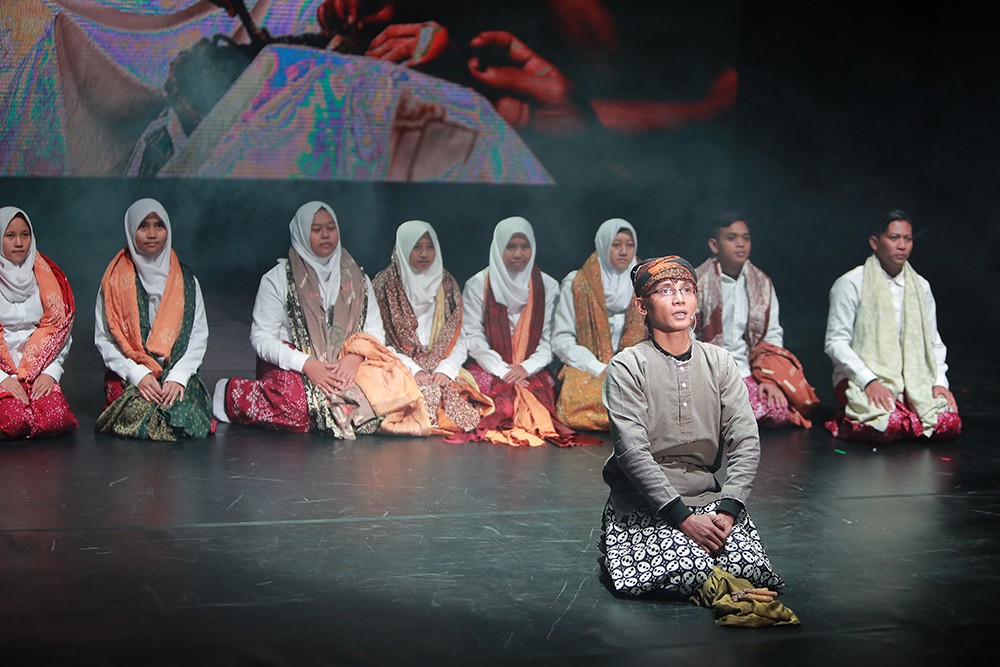
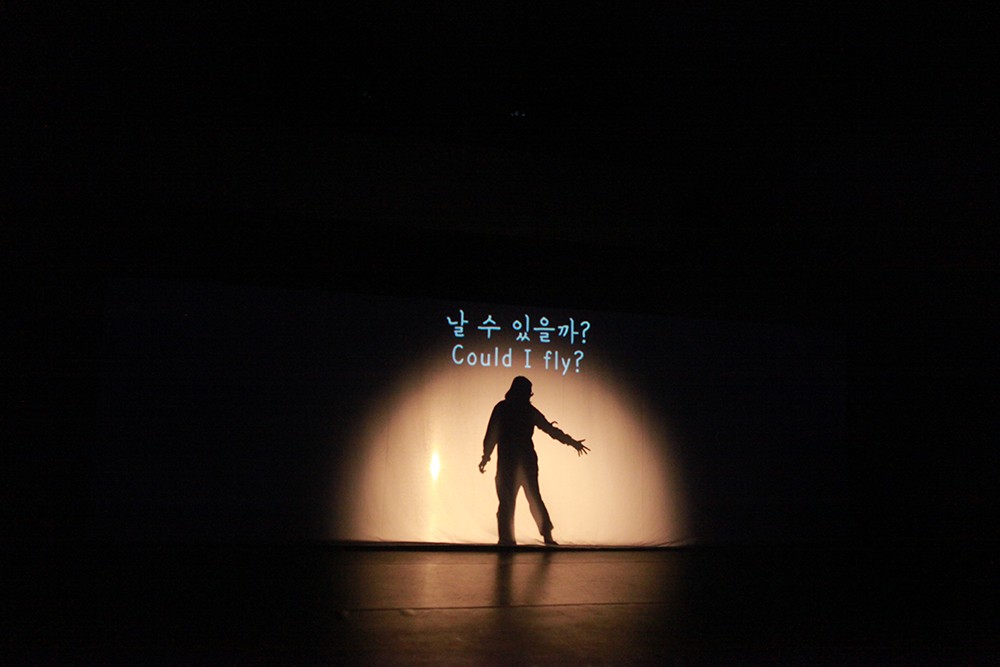
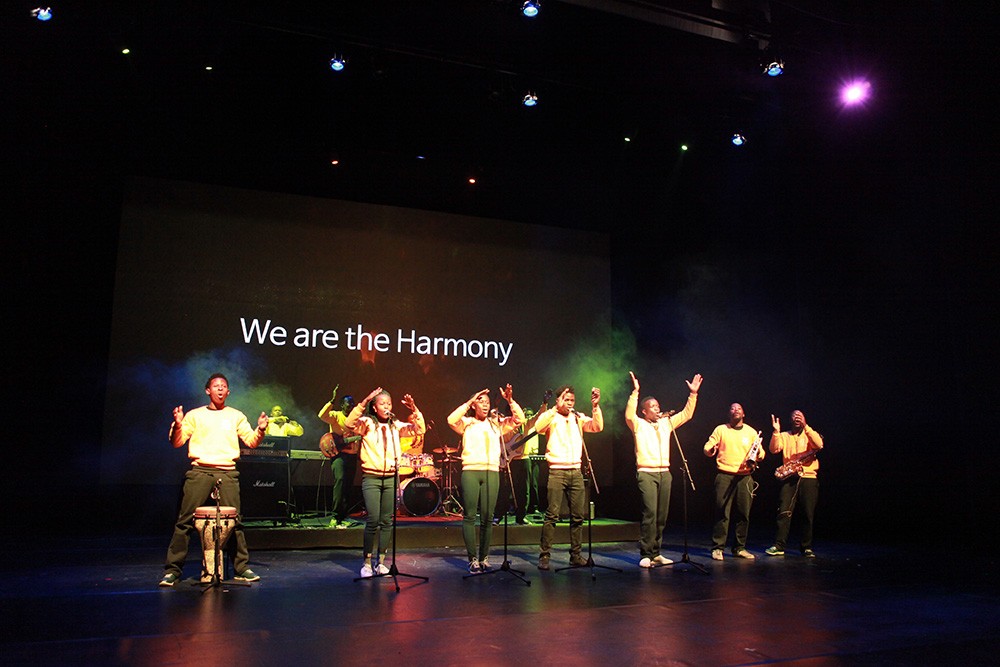
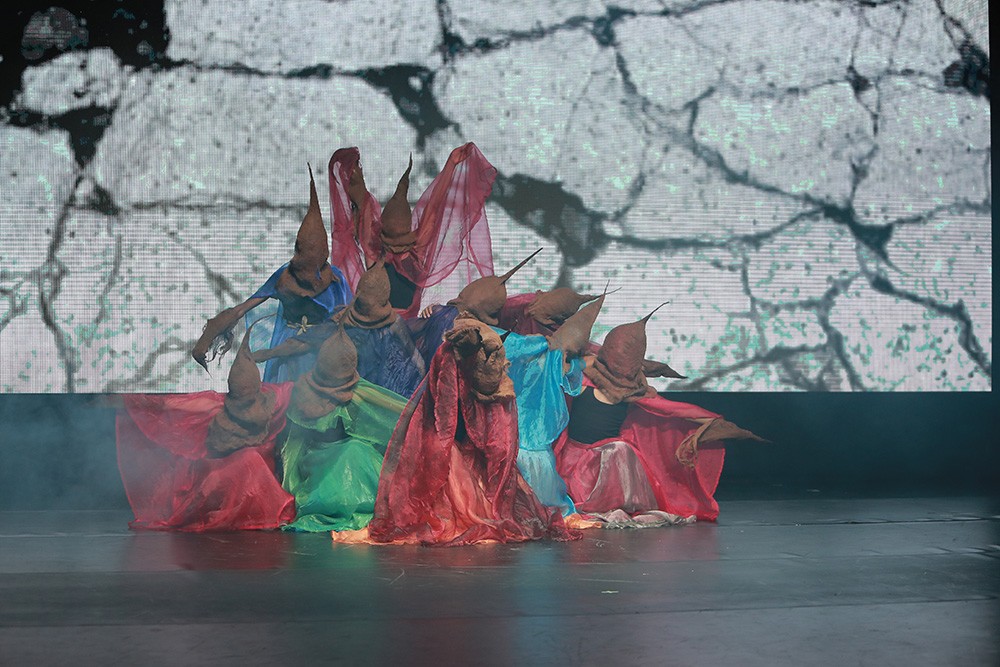
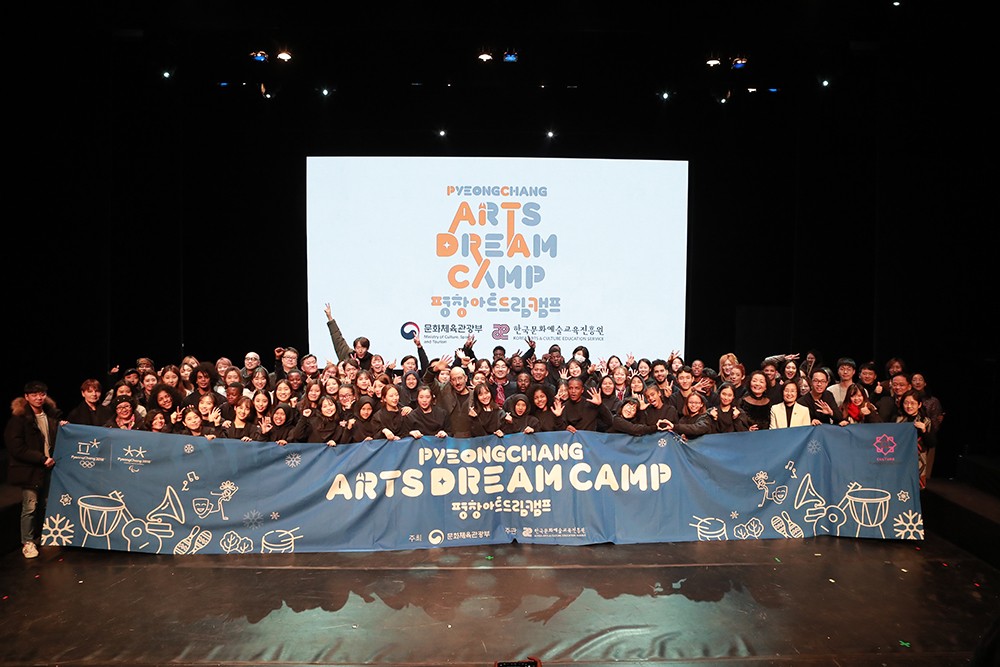
The Arts Dream Camp as an Olympic Legacy
For many of the participants, some of whom had traveled nearly 20 hours to come to Korea, the camp period of seven days and six nights flew by rather quickly. Although the students would have liked to spend more time outside of the performance preparation to get to know each other better and share other memories, it was not easy. Certainly, for many of the students, it was difficult to endure and adjust to the harsh winter weather in Korea.
Indeed, it must have been quite stressful to prepare such a grand performance with little rest in such a short amount of time; however, the children gave little sign of fatigue or distress, enjoying every moment of the camp and working as diligently as if the external elements had little to no impact on their energy levels. They were eager to open up about their dreams, express and share them with their new friends from the other countries, and work together as one to create their final performance. The attitudes and openness of the children is perhaps the most memorable aspect of harmony throughout the entire camp.
The Arts Dream Camp, which began as part of the PyeongChang Winter Olympics, will remain as part of the Olympic legacy for years to come. Even after its end, the camp is a symbol of the harmony and collaborative spirit that the Olympics embody, as well as of the passion and energy of all of the participants in this global event. Hopefully, this camp will be the first of many opportunities for the participants to share their imaginations and express their emotions for the world to see.
*Posted by Miso Han, International Affairs Team, KACES
Following changes proposed by the Moon Administration, arts and culture education is becoming more specialized to appropriately meet the different age groups of infants, young children, adolescents, adults, and the elderly. Of these proposed changes is the “Arts and Culture Education for the Turning Point of Life” program, which is geared toward those who are 50 years and older, and the introduction of this program has helped bring the importance of elderly education in culture and the arts to the limelight. With the increasing speed of aging in Korea’s modern society, there are also increasing concerns over how the arts can be used as a means of dealing with the reality of getting older. The questions raised mainly focus on how society should approach arts and culture education for the elderly. To discuss this, experts were invited to hold a discussion panel after monitoring the current state of elderly arts and culture education and identifying the relevant issues to draw future supports and policies. The panel served as a platform to bring these issues to everyone’s attention and discuss possible steps to reach a solution.
ㅇ Topic: Arts and Culture Education for an Aging-Friendly Society
ㅇ Date: Wednesday, 20th December, 2017, 3:30 PM
ㅇ Venue: Jongro micimpact
ㅇ Participants: Kang Won-jae (Arts Director, Gyeong-gi Sangsang Campus), Go Young-jik (Literary Critic), Kim Chan-ho (Cultural Anthropologist), Shin Dong-ho (Director, Institute of Humanities and Society), Yoo Hae-sook (Seoul Social Welfare Graduate University Professor, Department of Social Welfare)
Proposed Issue: The role of culture and arts in the lives of the elderly
Kang Won-jae: Today’s topic is the culture and arts of the elderly. The reality of an aging society has been an issue recently, and there have been many obstacles surrounding the lives of elderly in our society overall. We will begin by discussing what issues in particular the elderly are facing that culture and arts can help address.
Yoo Hae-Sook: As someone who studies social welfare, I believe the root of the problem lies in whether the elderly are provided with the capacity to partake in the culture and arts in our society. 50% of our elderly, which refers to those who are 65 years of age and older, are living in poverty, and work hard just to make ends meet. Most of these individuals are in their 70s or 80s, and just do not have the liberty of even considering to partake in the arts and culture. On the other hand, there is a group of “new elderly”, if you will, who fall in the age range of around 50-64 years, and are also known as the “Baby Boomer(born after the Korean war between 1955 to 1963,)” generation; their situation is quite different. There are over 7,000,000 of these “new elderly” individuals, and this accounts for 14.5% of Korea’s total population. Most of these individuals are well-educated and experienced the democratization movement. As such, they have actively participated in society and have different desires and self-perceptions of their roles in society that past generations do. Taking all of these into consideration, I think it is important not only to discuss how the culture and arts can or need to address the issues faced by the elderly population, but also how they can address the desires of the “new elderly” population.
Kim Chan-ho: There is a bit of a love-hate relationship between the lives of the elderly and the arts. The arts tend to pursue the new and the exciting, often bordering on the adventurous, whereas the elderly seem to prefer the conservative and avoid change. As such, it is often inevitable that the fundamental nature of the arts does not appeal to the elderly population in general. However, it is also important to note that the elderly are prime sources for stories that are unique to their generation, which can open the door for a unique style of learning of which we might not be aware. This is why it is important to understand when and in what aspect the elderly consider the arts to be a necessary part of their lives, and when they desire that connection with the arts.
A different approach: Refraining from the use of the word “problem” when referring to the elderly
Go Young-jik: Based on my personal experience with the elderly through anthropology, culture, and the arts, there needs to be a more comprehensive approach to understanding the relationship between the elderly and arts and culture. First, we must understand the nature of the elderly’s situation in meeting the basic daily needs of life from a social welfare perspective. Second, we must accept that the elderly have their own culture and arts. And finally, we must change our view of the elderly and see them not as a problem in our society, but as a co-existing population that justifies the need for an aging-friendly society. We must remember that there is a difference in how different generations perceive what they consider to be art; we must not be hasty in considering these differences as merely a “generational gap” and label the elderly as being “old fashioned”, but rather as their opinions being merely a different perspective that can be equally beautiful.
Yoo Hae-sook: I think you make a very important note in that regard, and how we as a society perceive the elderly in Korea is an important issue that should be addressed. We need to re-examine our understanding and attitude toward the elderly and change them for the better. Paulo Freire proposed that the concepts of “old” and “young” were not merely a difference in age but rather a difference in one’s curiosity and desire to seek out the new. Our society divides itself by age group into the “young” and the “old”, but then defines the “old” simply as those who act or think “as they always did” without any change. On the other hand, those who interact with their community and constantly ask questions and seek out new things are automatically considered to be “young.” If we are to adhere to this sort of classification system, then it is very possible for the elderly to be considered “young” if we encourage them to interact with their surroundings and ask questions. The elderly should not be limited to being treated as “old”, but must be granted the same opportunities to live just as the “young” do.
In today’s society, the elderly are suggested to be referred to as “senior citizens”, a word which has a rather interesting origin. The term “citizen” comes from the Middle Ages as word referring to the people of God. In other words, it referred to priests and clerics, who heard the messages of God and relayed them to the public. However, upon the introduction of the famous “I think, therefore I am” movement, “citizen” no longer referred only to the people of God, but rather to all citizens. Society was no longer based on the concept that only God was capable of thinking, and that people were meant to do God’s will; now, people embraced individualism and their capacity to think and act on their own volition. It is through this process that the “citizen” became the foundation of communal society, with his or her own rights and responsibilities. This also came with the desire to ask questions and strive for a better society.
What about the meaning of “senior”? It is rather simple, in that it represents the fact that these individuals have lived longer than their “juniors”, and, thus, has more experience and the capacity to guide those who lack that same level of experience. As such, when a less experienced individual is facing some sort of difficulty, those with experience are there to express their comfort and compassion and help them get back on the right track. It is in this regard that the elderly fit into this “senior” role, as they are wise and experienced enough to help others. As can be seen here, following this concept of “senior citizens”, the elderly are not meant to be the recipients of care and guidance, but rather leaders in the caring and guiding of others. We must accept this and help create a society that fosters this aspect of our elderly population.
Shin Dong-ho: I have actively conducted programs with the elderly for around 11 years, and I agree with the concept that the elderly should not be considered the “recipients” of a given activity, but rather the “leaders.” This was the approach I took when developing my programs, and there were many instances when the narratives of the elderly were met with a positive response once they were given the opportunity to be expressed within the context of modern society. The fact that this new approach was needed for the desired role shift of the elderly to be attained shows that culture and arts programs for the elderly cannot be developed with society’s current misconception of the generational divide. If the elderly are not given a platform where they can stand on their own, ask questions, and discuss life, then any such program can surely end in failure. This is especially important when considering that our elderly population is the last generation that grew up on oral narration or the passing down of history and experiences through storytelling. It is in this regard that any culture and arts program geared toward the elderly must emphasize this autonomy in sharing the silent wisdom that they have.
Also, as you mentioned communal activities, I would like to note that the region of Chilgok is currently offering adult literacy courses where participants learn how to read and write, and even put on theatrical performances. Recently, they have begun offering model walking classrooms as well. The story behind this goes back to the <Silver Culture Festival>, where elderly from this region who were selected to receive prizes did not have good posture. The walking class was designed to help elderly individuals in their 70s and 80s walk properly even if they could not stand up straight. This program was held along with the literacy classes, and the outcomes were more than satisfactory. I believe that being flexible in developing programs and meeting the needs of the elderly participants was important in achieving this result. In this regard, I think it is important that when designing future programs, we consider how the community can work together in addressing issues faced by the elderly.
Kim Chan-ho: One of the goals of arts and culture education is to encourage the development of one’s individuality and self-awareness. However, many of our elderly are cut off from the rest of society and rather inactive in community activities, and as a result are emotionally distressed. This lack of social interaction and the root of it must be identified and addressed before we can find a way to help the elderly through arts and culture education.
Go Young-jik: Society’s perspective and discourse of the elderly are also important in changing society. Currently, Korean society has a strong attitude against aging, and perceives aging as a negative phenomenon in life; from this perspective, we need to promote a shift to one that is more welcoming of aging. Japan has witnessed the introduction of group that try to promote this very perspective. Ueno Chizuko, a director and a renowned sociologist, wrote a book on preparing for aging to help society become more accepting of this inevitable phenomenon. I believe that Korea also needs to take steps toward taking a similar approach to the aging process.
Kim Chan-ho: There is a similar group in Japan known as “preparing for going downhill” with a similar premise.
Elderly Arts and Culture Education Begins with the Smallest Opportunities
Kang Won-jae: The elderly are in a constant battle with poverty, and are fearful of tomorrow even if they have money. Most of them have no support system and are afraid of having to face the world alone. With all of these worries occupying the minds and lives of the elderly, arts and culture education must find a way to enter the lives of the elderly through small opportunities, ones that are not overbearing, yet still potentially impactful.
There is a “toy hospital” in Incheon that is a rather good example of this. Elderly individuals who were engineers in their younger years have established a “hospital” where they repair broken toys for children from all over the country. There are also many elderly individuals in markets who have written poems based on the work that they and others in the markets do. Here we see another example of how the arts find a small opportunity with which it can impact the lives of the elderly.
Yoo Hae-sook: There are also cases of the elderly reading to children at children’s centers across the country. The great thing about it is that they do not simply just read the stories, but also try to empower the children with their wisdom and past experiences. These individuals use books as a tool for creating an opportunity of an exchange between the young and the old.
Many social welfare centers offer culture and arts activities as part of their programs, but these are usually only ways to pass the time. In other words, after the program ends, there is a lack of fulfillment felt by the participants. Compared to the cost of these programs, there is very little impact or change that comes from them in regard to the interaction shared between the elderly and their communities. The foundation of social interaction involves asking questions of one and of others, and a quick assessment of these programs shows that they do very little in contributing to such factors. These programs need to offer the elderly an opportunity to learn more about themselves and the roles that they play in their communities, not simply remind them of the fact that they are elderly.
Shin Dong-ho: It is indeed the case of today’s society that we tend to view the culture and arts as nothing more than leisurely activities, mainly meant to be enjoyed by those who are working hard and living their lives diligently. I once visited a social welfare center and recommended to a few individuals playing in the orchestra to perform outside of the facility, knowing that it would be a truly different experience to interact with the community outside of the walls of the center. This is the same approach that needs to be taken in developing any sort of program for the elderly. Recently a school in Chil-gok served as the location for a television program where local elderly residents present their cooking skills. This had a huge impact on the people in the village. We need more programs like this that encourage the elderly to be a part of everyday society.
Another pressing issue for the past four years is the lack of collaborative planning. There have been fewer opportunities, if any, to gather and discuss issues like those affecting the elderly. Supportive efforts have either been in the form of monitoring or review, which makes it difficult for us to see exactly what steps have been taken in detail.
Go Young-jik: The limitations of programs in facilities where age groups are isolated from others is indeed a serious issue. Most of the elderly individuals at senior welfare facilities are only offered the option to shop for different programs, and their attempts at discussing their past experiences usually end up being perceived as recollections of their failures, and not of their successes. However, I believe that it is important to focus on the stories of the elderly as information resources for future generations. We need to consider ways through which we can build upon that connection.
Kim Chan-ho: On that note I think it is important for us to think closely about the goal of any education program. The goal of education is not simply to upgrade one’s self as an individual, but also to use that opportunity as a way to give back to the community. If you look back at small communities where arts and culture education was possible, the source was always through interaction with the elderly. In Daejon, a special program called ‘Roots and Shoots’ involves young children meeting with the elderly and sharing their stories with each other. Programs for the elderly should not be geared toward the elderly alone, but also developed in a way that they meet with the society and give back to their communities.
Considering the Differences within the Elderly Community
Kim Chan-ho: Until now we have been addressing the elderly community as a whole and speaking in general terms, but it is important to acknowledge that there are generational, gender, educational, economic, and other differences within the elderly community as well.
Kang Won-jae: Some of those in their 60s go to senior welfare centers and come out unsatisfied because they think they are being forced into volunteer work, whereas those in their 80s believe that they are too old to interact with others and thus exclude themselves. Due to these varying differences in how the elderly feel about these centers, we need to consider the “Roots and Shoots” program as a model and encourage meeting new, unfamiliar age groups as part of arts and culture education.
Yoo Hae-sook: When looking at it from a general perspective, the elderly in society are considered to be the age group in society that is the collective recipients of care. Particularly for those who are left in senior centers, they are cut off psychologically, socially, and physically from the rest of society. For these individuals, culture and arts activities are presented as ways to simply pass the time, short-lived hobbies, or, even worse, volunteer work. On the other hand, for the “new elderly”, active ageing is the norm, leading into the concept of successful ageing; in other words, these individuals believe that they need to stay active and consider productive culture and arts activities as ways to live healthy, successful lives in their later years.
However, this positive outlook does not come without a negative impact. As the emphasis is placed on this “new elderly” life approach of active and successful aging, the elderly group is increasingly perceived as carrying out an inferior lifestyle. This is also detrimental efforts between the elderly and new elderly groups, as there is a discrepancy in their perspectives that is often misconstrued as the elderly teaching or imposing their ideas upon those younger than they. It is in this regard that we need to take a step back and see which direction Korea’s arts and culture education program needs to be taken. In order to do so, we need the perspectives and collective observations of all different areas of academia and society to enable smooth cooperation and exchange.
Go Young-jik: The fact that we are using terms such as youth, young adults, and elderly is in essence already creating a divide between age groups. When looking at things from a natural perspective, a person’s life is not divided according to the divisions that we have created. There is no doubt that there are going to be differences between the “new elderly” and those in their 70s and 80s. Having worked with those in their 50s and over, who are tomorrow’s “new elderly”, it was clear that their independent drives were still very strong. They expressed a sense of initiative in addressing their concerns over how they would continue to live their lives, working together with their community to find potential answers. While the “new elderly” were proactive in their approach to life, the same cannot be said for many of the elderly; as such, respective programs need to be developed to accommodate these fundamental differences.
Kim Chan-ho: When looking at the history that those in their 70s and 80s have lived through, there was no concept of culture when they were young, as old traditions were mostly ignored and inevitably forgotten amidst the country’s rapid economic growth. On the other hand, the Baby Boomer generation was raised on the life approach of trying new things and fighting for what one believes in. However, even this generation is still within the paradigm of a labor society.
Shin Dong-ho: I hope that policymakers will take a more detailed and careful approach when developing policies related to the culture and arts in relation to the elderly, as there are differences between all age groups. Even among the Baby Boomers, there is a difference in the needs of those living in the city and those living in the countryside. Policies need to be all inclusive, covering all different characteristics and diversity of this age group.
Social Change and Intergenerational Exchange
Kang Won-jae: There needs to be a channel through which we can express to the elderly that the technical expertise they have is still valid and valuable to today’s society. There is a workshop at the Sewoon Arcade that promotes a system for this very purpose. There are many elderly individuals who believe that their experience in repair, which was their means of earning money and surviving when they were younger, is no longer of use or service to today’s society. However, those running this workshop reached out to these individuals and brought to their attention that there is still a need for that technical expertise. They would see the happy and thankful looks on the faces of their clients who would bring their father’s broken audio players, and at that point realized that there was a place for them in society after all.
These individuals then decided to work together with their younger counterparts who started the whole process to create a sort of “Fix-it Workshop.” This is another example of how the younger and older generations can work together in society to create a new type of relationship.
There is also an instance of adults working together with some elderly individuals who would collect and store recyclables, creating a “Maker Space” where older and younger individuals would work together to create things. Their creations would later also go on display at exhibitions in museums, and this is something that could most likely have only come about in a public area.
* Fix-it Workshop: A place where repair experts at Sewoon Arcade bring memories to life by repairing old electronics that have sentimental or otherwise meaningful value.
Shin Dong-ho: Once in Jindo there were elderly craftsmen who made arts and crafts in the shape of the famous turtle ships from history. These were not originally models that they made, but rather the result of their creativity after they were challenged to make something different. Also, we once gathered 10 random males, and around five of them knew how to cook ramen noodles, and around two of them knew how to cook rice. We then conducted a cooking class with them, and the response was better than we expected.
Kim Chan-ho: Another possible activity could be to write an autobiography across generations. Also, elderly drivers are increasingly prone to motor accidents, which often results in their voluntary giving up their licenses. In Japan, there is a project that plans a graduation ceremony for elderly individuals who give up their licenses, so that they do not feel like they are being left out by society. These are just some examples of how we can give new meaning to certain events that take place in a person’s life.
Go Young-jik: The elderly are also at the center of convenience stores in Japan, which have individuals standing by to help elderly customers in an overall ageing-friendly environment. In the end, as examples show, society as a whole needs to have welcoming attitude towards the elderly. Seoul is gradually progressing to an elderly-friendly city, but policies need to be made to support these changes. Sweden’s social welfare policy was developed in 1930 as a part of population policy under the concept of “preventive social policy.” For Korea, we, too, need to take an active approach in policy changes for society to embrace the elderly. This cannot be accomplished through arts and culture education alone.
Yoo Hae-sook: In Korea, culture and arts are not seen as a necessary part of life. Since the field is not a contributing factor to survival, it does not exactly receive the spotlight as a necessity. Only in a society where human rights are protected and safety is ensured are culture and arts are seen as necessary parts of life as outlets for leisure. Take Sweden, for example, where it is believed that for a happy life, all people in society must treat one another like family. In 1928, Prime Minister Per Albin Hansson stated that no house should divide its own people by those who are oppressed and those who are not. He went on to say that all of those under the same roof live equally, treat each other with respect, and work together to maintain a happy lifestyle. This approach became a reality in the mid 40’s thanks to the determination of the Swedish people. While it is encouraging that in our society culture and arts are gaining attention, we will not be able to expand upon society’s access to culture and arts until our right to live is guaranteed as it is in Sweden. However, if culture and arts become a medium through which individuals in society can grow more self-aware and help those around them live their lives more fully; this can truly serve as a sign of hope.
Go Young-jik: Sweden also experienced a near-civil war starting in 1950. During this time, social welfare experts played an important role. However, in Korea, the same experts are not proactive, but rather accept government policies as they are.
Kang Won-jae: I do agree that social welfare experts in our society are rather passive, but we cannot ignore the fact that they face a number of obstacles. The issues we are facing are not those that these social welfare individuals can solve on their own. These issues are more comprehensive and require the attention and action of society as a whole.
To review what we have discussed so far, we have gone over the perception of “elderly problems”, the problem of a paradigm shift, what platform culture and arts can prepare, the need for promoting interaction between the younger generations and the elderly, and connecting the elderly with society through the public sector. We also discussed how the perception of elderly must shift from those who need to “receive” care to those who can “provide” it, the differences among the elderly (60s and 70s, male and female, countryside and city), the need for new spaces where older and younger generations can work together, the limits to addressing the problems affecting the elderly as solely an “elderly problem”, and the need for taking a whole-of-society approach to this issue.
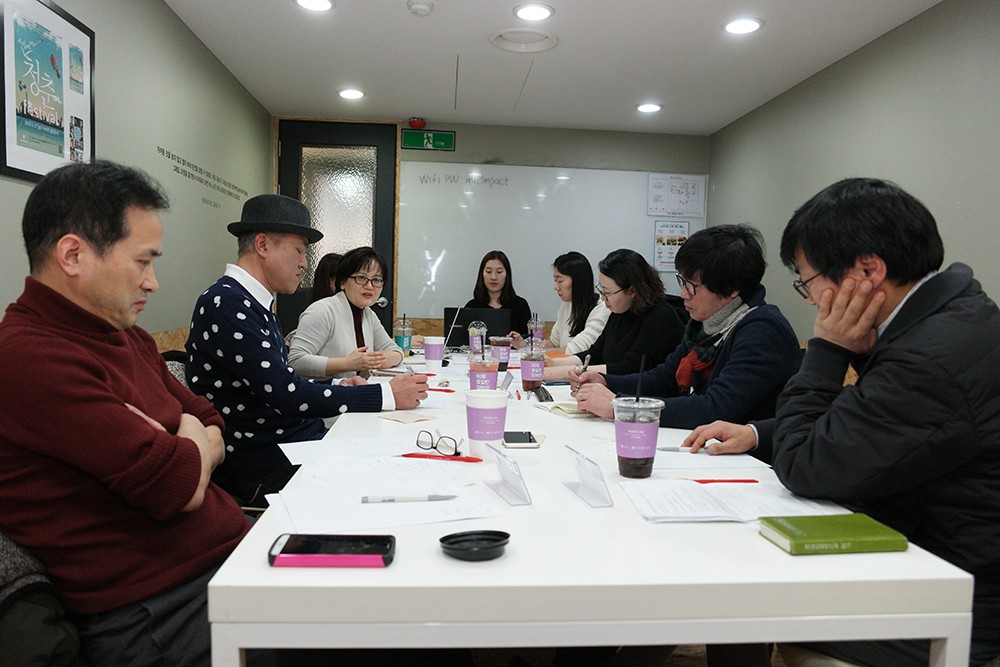
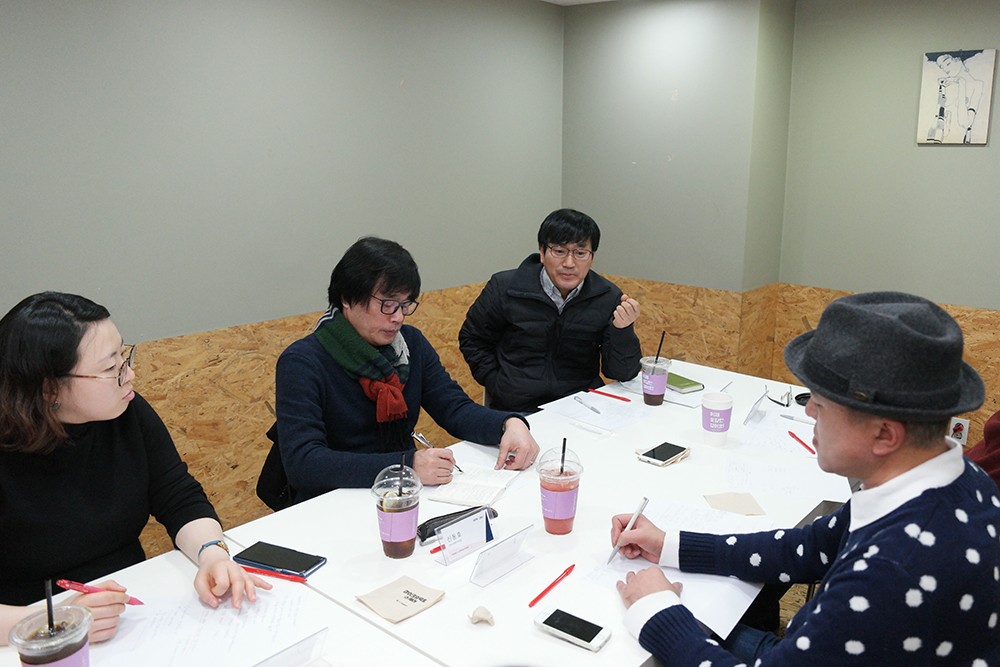
Opening an Alternative Path: Culture and Arts Create a Joint Community
Shin Dong-ho: Although it is an issue that culture and arts are not considered essential to our society, another issue is that culture and arts are seen merely as tools. Arts and culture education in schools are simply technical and too strictly conducted, potentially hindering the capabilities of children who were born with natural artistic talents. I believe that rather than having these children invest in external resources to foster their talents, we need to invest more in ensuring that the main education provided to them is of good quality. We need to shift to a system where we create and support ecosystems for arts and culture education. We need social welfare experts to get involved at senior centers and create their own system of communal arts and culture education and exchange, boosting their self-esteem and developing programs that use their own stories as a way to interact with the elderly. I believe it is an important role of the KACES to create this ecosystem approach where the elderly, for example, are provided with the proper tools that they need to build interest and develop a positive response to learning about the arts and culture.
Yoo Hae-sook: The elderly are a rather complicated aspect of society, for they face problems in income, physical health, families, and psychological health. As such, it is hard to have certain individuals or certain institutions claim responsibility for elderly individuals. If such a trend were to continue, those responsible would become exhausted. This is especially true if one team within an organization is overwhelmed and another is not; it causes a lack of connection within the organization itself, causing administrative and communication problems. In other words, social welfare experts do not have the capacity to tackle these problems on their own. However, we cannot simply give up; those actively interacting with the elderly on site should be the agents of change. The stronger they are, the better we can interact with the elderly and create a community that works.
Kim Chan-ho: Rather than having arts and culture education become yet another task for social welfare experts, I believe that through such education their work should become somewhat easier. In Being Mortal, elderly patients in a nursing home are presented with parrots and cats to treat their loneliness and lack of energy. Although the response of the elderly residents was one of disbelief and discomfort at first, soon they began to see these animals that they were raising as reasons to live. I hope that arts and culture education can have the same effect. Another example took place in a senior center of an elderly person who used theater and acting as a way of overcoming their feeling of being neglected by society. In this way, arts and culture education can raise self-awareness and help these individuals deal with the ups and downs of life. Art finds a way of combining the subconscious of children and the conscious of adults. It can help paint a picture of elderly life that is no less impressive or attractive than that of a younger individual.
Go Young-jik: In the end, every individual thinks about how they will live out the rest of their life.
Everyone wonders about how they can give the most meaning to the next 24 hours of their lives. I believe that both on a personal and social level, the act of creating something is amazing. In that process of creation, through new, cultural alternatives, we can find other models of life to which we can refer. This can help make it possible to switch to a Senior Shift society, where everyone’s problems are shared, with your problems becoming my problems, and my problems becoming yours.
Yoo Hae-sook: One of the problems with society’s perception of the elderly is it sees them as lazy individuals who become the source of complaints. Such attitudes push the elderly into a corner away from the rest of society, which the elderly have no choice but to take out on those closest to them, most often those working in the senior centers. If we can introduce arts and culture education to the elderly and create a community where they are not merely the recipients of care and negative attention, I believe that there will be many opportunities for the elderly to become contributors to society. This is why I believe today’s discussion is of such great importance. I hope that there will be more opportunities in the future to discuss the direction of arts and culture education, as only through open discussion and subsequent action can we bring about fundamental change.
Shin Dong-ho: In regards to the issue was raised of culture and the arts as a means, a tool, or a medium, Marcel Proust once said something along the lines of that true journey is not characterized by seeing new sites, but rather by looking at things with a new set of eyes. Arts and culture education has a set angle from which it approaches situations, and until it changes that approach, it will be nothing more than just a means or a tool for achieving something. Kim Young-nam once said that taking a picture is not taking a snapshot of the subject but rather the perception with which the photographer beholds the subject. In that regard, with arts and culture constantly being seen as a tool, I think we need to change the way it is perceived in society. We need to change the very process with which it is presented to society for it to be used in the way it was meant to be.
Kim Chan-ho: As it stands arts and culture education is not something that smoothly incorporates itself into everyday life but rather something that is divided into different genres. There needs to be a revival of the capacity of culture and arts to bring creativity to life. Lecturers, artists, and all others involved must find a way to simultaneously create and recover their own lives.
Go Young-jik: I recently read a book written a few years ago by Helena Norberg Hodge titled Ancient Futures. It recounts the story of an 80 year old elderly individual who fixes a roof and then passes away the next day. The Ladakh people believe that the tiger’s stripes are outside the tiger’s body, while the human’s stripes are found within. I believe that arts and culture education play an important role in finding the stripes of elderly individuals deep within. Rather than seeing the elderly as old individuals with a history, we need to change our perspective to understand them as individuals who are living in the present. I believe that arts and culture education can help us in changing our perception of the elderly in this manner.
*Posted by
Kang Won-jae Kang studied industrial engineering at Ulsan University and Art at Hongik University. He prefers going by the nickname “Kang-goo-yah.” He has gone beyond the field of arts and culture and is active in cultural planning and partakes in alternative education, event planning, and cultural and urban revitalization. He is currently the Chief of XX University Institute and Director of the Re-Sewoon Collaborative Support Center.
Go Young-jik A literary critic who believes that people are defined by their stories. He has written pieces on the Baby Boomer generation and the topic of the elderly, including What is Your Story and The Elderly Arts Class.
Kim Chan-ho Kim is currently the Vice Director of the educational center “Inner Teacher” and is a professor at Sungkonghoe University Liberal Arts School. He studied sociology and has taught a variety of courses including cultural anthropology and education. He has also written a number of literary works, including Discovering Culture, The Humanities of Money, Humiliation: Social Emotional Studies of Disgrace and Dignity, and Poor Speech.
Shin Dong-ho Shin is active in a variety of different fields, including cultural policy, cultural event planning, arts and culture education, and community revitalization. He is part of the KACES as an analyst and consultant, a steering committee member at the Daegu Art Factory, a member of the Gyeongsangbuk-do Arts and Culture Promotion Committee, and has been working in the region of Chil-gok since 2012 in developing the Humanities City. His works include a collection of poems from the elderly women in Chil-gok, entitled What is Poetry? (2015), stories from Maemul Island in I Want to Walk Along This Ocean With You (2012), and around eight other works that have either been planned or published. Also, over the past 10 years he has pursued various efforts in developing systems for lifelong education and urban development with inhabitants’ initiative. He currently serves as the President of Communitas and the Executive Director of the Institute of Humanities and Society.
Yoo Hae-sook Yoo studied English literature and social welfare and is currently using anthropology and sociology as media for meeting and learning from members of society. She currently teaches at the Seoul Social Welfare Graduate University Professor in the Department of Social Welfare and serves as the Chairman of the Water for Change Program for Civic Education and Social Policy.
According to the Article 6, Clause 1 of the Support for Arts and Culture Education Act, which was reformed in 2015, Arts Council Korea must deliberate on a comprehensive plan for arts and culture education every five years. As such, the Ministry of Culture, Sports and Tourism (MCST) and the Korean Arts and Culture Education Service (KACES) have collaborated to gather data since 2016. Following meetings of the subcommittee and advisory committee, a large conference was held with the 17 metropolitan areas of Korea. The conference attendees included the KACES and the regional culture and arts centers from the 17 main cities and provinces in collaboration with local governments, culture foundations, regional education offices, regional experts, and other relevant representatives. Their comments and opinions were shared and collected, based upon which the 5 Year Comprehensive Culture and Arts Education Plan was developed. The plan was then announced on January 11th.
At the most recent Arte365, three experts discussed the aforementioned comprehensive plan. Research Director Park Young-jeong of the Korea Culture and Tourism Research Center, shared her thoughts on the impact of the comprehensive plan, Team Director and on-site contact Son Dong-hyuk of the Incheon Culture Foundation discussed the regional perspective of the comprehensive plan, and Director Hong Yoo-jin of the KACES shared thoughts on the implications of the comprehensive plan.
A New Milestone Marking the Turning Point for Arts and Culture Education
Park Young-jeong (Korea Culture and Tourism Research Center, Director of Arts Policy Research Division)
The fact that the recently announced comprehensive plan is the first official plan of its kind reinforces it as a milestone marking a turning point in arts and culture education.
Korea’s arts and culture education has made great progress due to the strong drive of the Korean government, which has made relevant policies and laws, established agencies, and allocated national funds to the promotion of arts and culture education. Culture and arts centers have been introduced to the 17 large cities and provinces across the country, and outreach programs are being developed to provide the same education opportunities to areas outside of the main cities. As of now, national funds have been serving as seed money for the regional culture and arts centers, which shows how high of a priority arts and culture education is being regarded as by the Korean government. The 5-year Comprehensive Plan serves as the blueprint for government policies in the area of arts and culture education, and it covers not only the plans of the MCST, but also those at the city and provincial level. If the plans are implemented at the city and regional level following the proposition of the comprehensive plan, it will certainly serve as a milestone in the area of arts and culture education.
Perhaps the most impactful change that this plan can introduce is the “regionalization” and “diversification” of arts and culture education. If this plan were to be implemented, arts and culture education planning will be conducted at the regional level, decentralizing the current system further strengthening the roles of metropolitan culture and arts centers and further promoting fundamental culture and arts infrastructure nationwide.
However, the problem still remains that in order for decentralization to be successful, regional capacity for sustaining such educational infrastructure must be established. As such, planning alone cannot ensure the success of these changes. Perhaps the Annantalo* style centers known as “Dream Art Centers”** could serve as the key to linking the divide between schools and regional culture and arts centers in order to accommodate the decentralization proposed by the comprehensive plan.
*Anantalo Art Center: This is an art center in Helsinki, Finland that serves as a public culture and arts center as well as an arts education institution. Once an old school that was shut down in 1886, the building was refurbished and re-established as an arts education center for young children in 1987. **“Dream Art Center”: Similar to the Anantalo Center, these centers transform shutdown elementary schools into arts and culture education centers.
Furthermore, there needs to be an increased focus on strengthening customized education for each level of society, and introducing a broad spectrum of education, including the humanities, cultural diversity, media, cultural relics, and other comprehensive programs. The thing to keep in mind that promoting a “multifaceted, demands-based approach” cannot stop at simply providing a diverse number of educational options, but rather creating a system for arts and culture education with its foundation built on embracing all of these different values.
The fact that this comprehensive plan will decide the new direction of arts and culture education in Korea is highly deserving of our attention, and requires our strong and open communication and collaboration to ensure that all opinions and ideas are shared to ensure a stable, practical implementation of the plan for a new model of arts and culture education.
The Start of Regional-Based Arts and Culture Education: A Long Way to Go with Very Little Time
Son Dong-hyuk (Incheon Culture Foundation, Culture Education Team Director)
In recent years, the importance of arts and culture education has been increasingly reinforced. This is a result of society’s growing awareness that such education can enhance an individual’s appreciation of artistic beauty, help develop one’s creativity, boost one’s capacity to communicate,better understand others and as a result contribute in resolving social and cultural matters. It is believed that strengthening society’s general capacity for culture can in turn positively impact society’s capacity for creativity and innovation, ultimately leading for an increased capacity for handling and solving problems that face society. In order to systematically support such a means of capacity enhancement, the Support for Arts and Culture Education Act protects and fights for the right of every individual’s access to arts and culture education.
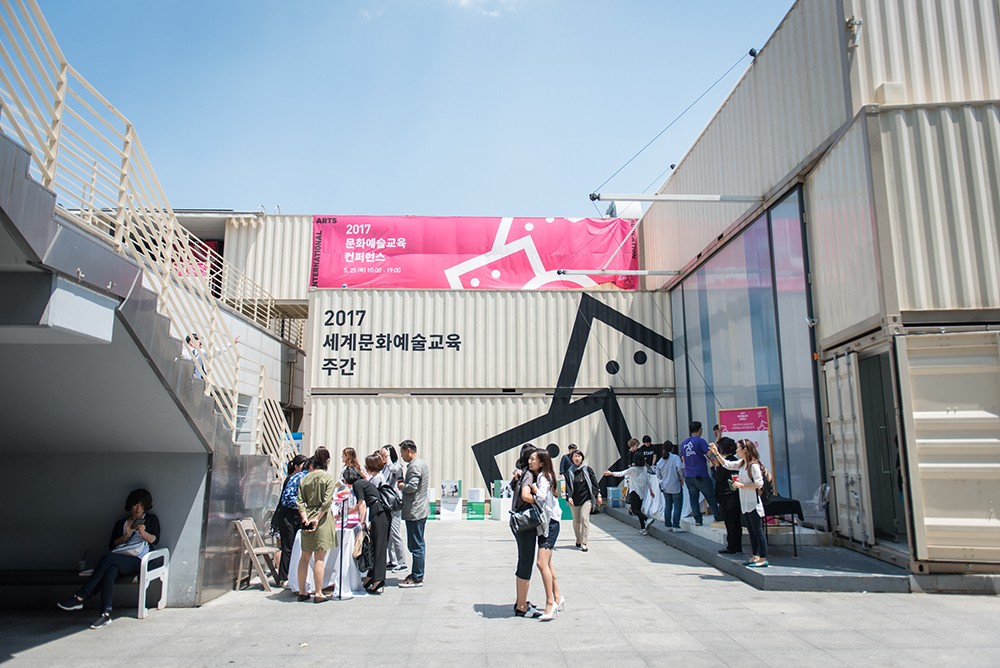
Every individual’s life finds its foundation at the regional level. In that regard, it seems only obvious that arts and culture education should be developed with the regional systems at its center. However, over the past 10 years, steps taken in arts and culture education development at the regional level have been nothing short of inadequate. When reviewing the proposed comprehensive plan, it is impressive to see that there are steps being taken for the restructuring of arts and culture education in a region-centric and needs-based manner to improve the quality of arts and culture education. Furthermore, this will allow relevant stakeholders to meet the needs and demands of individuals and provide them with more opportunities to partake in arts and culture education throughout all stages of their lives. It is undoubtedly meaningful that the efforts taken in planning this comprehensive plan included discussions with the 17 different major cities and regions across the country to ensure that the needs for all people at all levels of society and all areas were addressed.
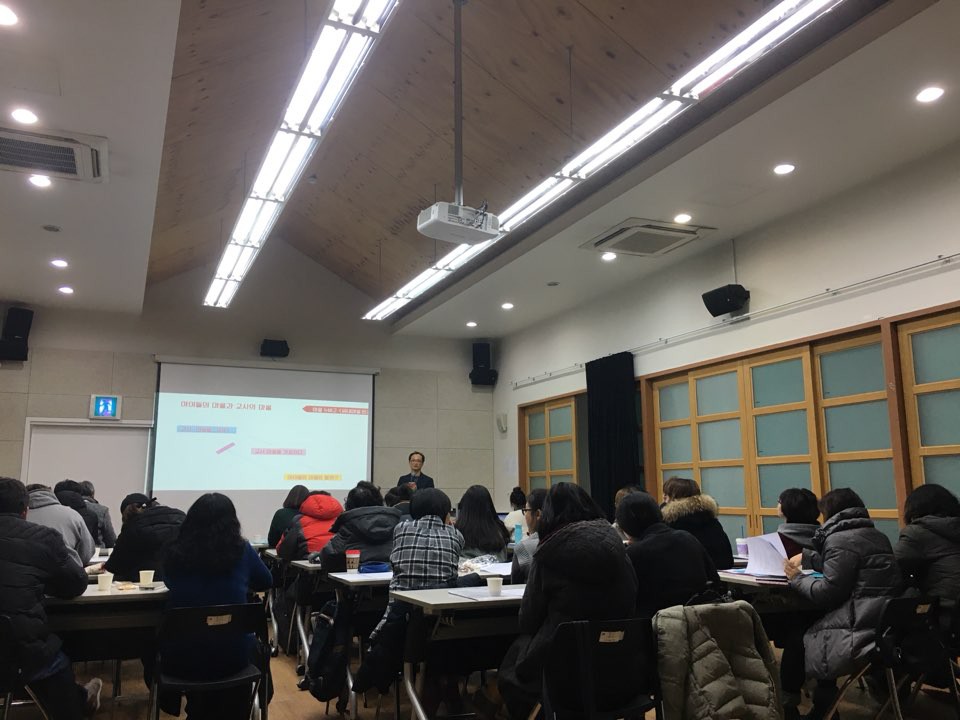
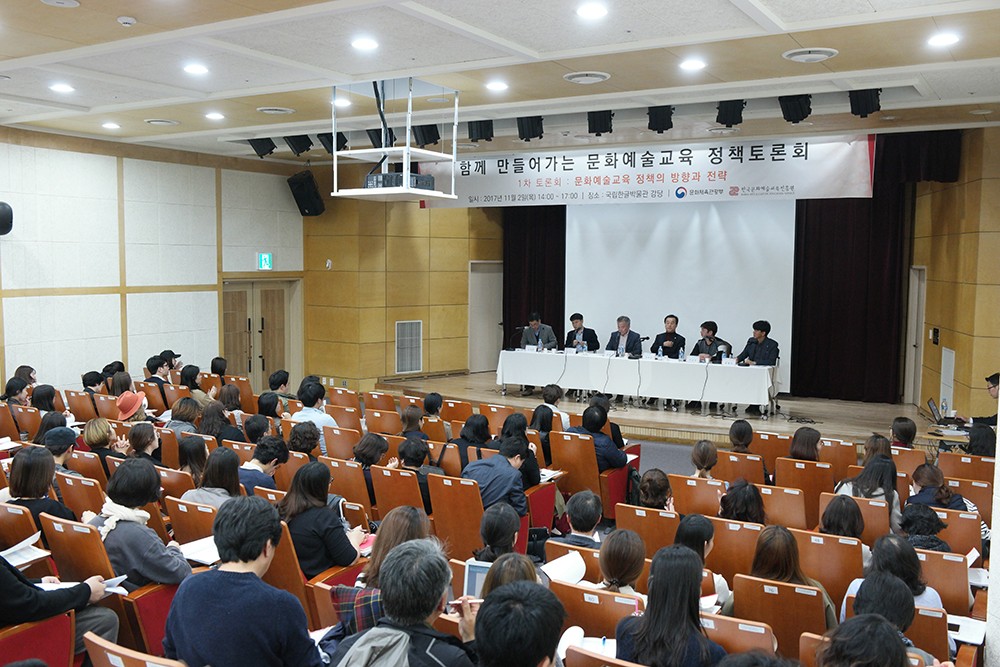
The first step to reforming arts and culture education is to establish a system for arts and culture education at the regional level. With regional arts and culture centers as the main operating bodies, there would be a need to redefine the roles of KACES and MCST.
The proposed roles would be for MCST to be in charge of preparing for the legal aspect of any changes, as well as facilitating intersectoral communication with Ministries, while the KACES would be in charge of supporting the regional centers and establishing a system for gathering data, on the efficiency of different policies, improving international exchange and conducting planning, management, and implementation of regional art center related tasks. Also, in order to break free from the previous perception of arts and culture education and embrace the new regional-based approach, arts and culture education offered at schools and in society must be considered to be one and the same.
However, considering that things have been the same for the past 10 years, it is doubtful that a sudden change will catch on without any problems. As such, the role of the KACES Regional Coordinating Committee*, which was established in early January, is that much more important. Specifically, the committee is expected to review and fully understand the content of the comprehensive plan and prepare accordingly for a smooth transition at the regional level. Regional arts and culture centers will also need to move quickly in order to prepare for the changes to come by improving upon the rather poorly structured regional culture and arts support conferences and ensure that the implementation plans accurately match the needs as outlined in the original regional arts and culture education plan.
*KACES Regional Cooperation Committee: In respect to the decentralization of cultural policy, this committee is responsible for coordinating the central and regional representatives in implementing arts and culture education and preparing for gradual regionalization
In order to ensure a smooth transition into the implementation of the proposed comprehensive plan, all of these preparations must be made by June of this year. There is still a long way to go and not much time; as such, we will need to rely on the judgment and wisdom of those directly working on this project and their passion for successful arts and culture education reform.
Building Arts and Culture Education Together
Hong Yoo-jin (KACES, Director of Arts Educational Affairs Division)
The comprehensive plan for the next five years(2018~2022) of arts and culture education policies has been released. Although such plans have been released since 2004*, this is the first time that the plan has been developed through consultation and consideration of each region across the country in deciding what steps need to be taken next. From what it seems, the appropriate steps have been taken to include not only the opinions of the central government, but those of the local government as well in developing a true, comprehensive plan that takes the needs of all regions into consideration.
* Note: Comprehensive Plan for Culture and Arts Education Revitalization (Joint Statement by Ministry of Culture and Tourism & Ministry of Education and Human Resources Development, 2004), Mid-to Long-term Strategy for Culture and Arts Education Revitalization (Ministry of Culture and Tourism, 2007), Revitalization Plan for Creativity and Personality Development in Elementary and Middle School Culture and Arts Education (Joint Statement by Ministry of Culture, Sports and Tourism & Ministry of Education, Science and Technology, 2010), Mid-to Long-term Development Plan for Culture and Arts Education (Ministry of Culture, Sports and Tourism, 2014)
This comprehensive plan boasts the vision of “Arts and Culture Education as a Part of Life”, with the goals of redefining systems, goals, and infrastructure, as well as establishing the foundational ecosystems in each respective region, creating a multifaceted educational system based on needs and demands, and enhancing basic arts and culture education. By diversifying arts and culture education based on regional needs and demands, this plan will aim to provide continuous arts and culture education throughout the entirety of one’s life. The policy is not exactly directed toward often-neglected groups in society or select age groups, but rather meant to provide various opportunities for all individuals across all age groups. Of course, the exact details will be conducted according to the comprehensive plan, but the implementation will need to be conducted according to the capacity of each respective region at each point in the plan’s timeline.
The establishment of regional ecosystems for arts and culture education was mentioned to some extent in the 2014 mid-to long-term arts and culture education development plan, but it was not implemented as planned. With this plan focusing on the regional level of development, such ecosystems will be important to ensure that each region will have the capacity to provide and maintain its arts and culture services based on the needs of individuals in the region. In this regard, arts and culture education places a greater emphasis on the need for regionalization than other areas, thus lying at the core of arts and culture policies, not simply through decentralization and shifting the burden to each individual region, but by utilizing the unique resources of each region and encouraging collaborative efforts to create a more efficient, wide-reaching system.
Regionalization does not refer to cooperation within each region, but also requires the establishment of roles for both central and regional bodies and a systematic partnership between them.
This comprehensive outlines a strategic approach to regionalization by establishing a system with local governments outside the metropolitan area as the operative unit, as well as facilitating networking at the regional level and promoting cooperation between the central and regional bodies.
By introducing a governance system with individual regions as the primary strategic unit, the KACES can further strengthen its capacity in contributing to policy development, research and training efforts, international exchange, and value building. Of course, for all of this to be possible, a sophisticated collaborative system for strategic implementation will be required. In realizing the goals of this proposed comprehensive plan, the KACES will need to work closely with the Regional Arts and Culture Education Support Center, as well as other arts and culture education policymaking bodies to further enhance the value of arts and culture education and make it more available to all.
*Posted by
- Park Young-jeong (Korea Culture and Tourism Research Center, Director of Arts Policy Research Division)
- Son Dong-hyuk (Incheon Culture Foundation, Culture Education Team Director)
- Hong Yoo-jin (KACES, Director of Arts Educational Affairs Division)